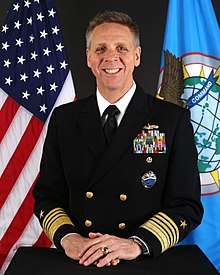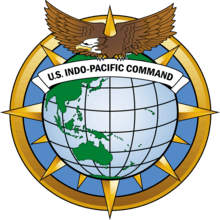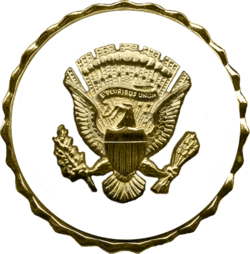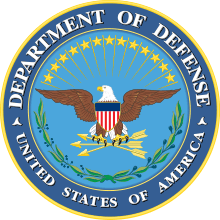Philip S. Davidson
Philip Scot Davidson (born August 24, 1960) is a four-star admiral in the United States Navy who currently serves as the 25th commander of United States Indo-Pacific Command since May 30, 2018. He previously served as the commander of United States Fleet Forces Command and United States Naval Forces Northern Command from 2014 to 2018. Davidson is from St. Louis, Missouri, and is a 1982 graduate of the United States Naval Academy.
Philip S. Davidson | |
|---|---|
 | |
| Born | August 24, 1960 Cincinnati, Ohio |
| Allegiance | United States |
| Service/ | United States Navy |
| Years of service | 1982–present |
| Rank | Admiral |
| Commands held | United States Indo-Pacific Command United States Fleet Forces Command United States Sixth Fleet Carrier Strike Group 8 USS Gettysburg USS Taylor |
| Battles/wars | Gulf War |
| Awards | Navy Distinguished Service Medal (2) Defense Superior Service Medal (2) Legion of Merit (6) |
On April 24, 2018, the Senate Armed Services Committee confirmed Davidson to succeed Admiral Harry B. Harris Jr. as the commander of United States Pacific Command. The change of command ceremony happened on May 30, 2018.[1] On that same day, United States Pacific Command was renamed to United States Indo-Pacific Command.[2] When Admiral Kurt W. Tidd retired, Davidson received the title of "Old Salt," , presented the longest serving SWO officer. [3]
Naval Career
A surface warfare officer, Davidson has deployed across the globe in frigates, destroyers, cruisers, and aircraft carriers. Davidson's previous command assignments include Carrier Strike Group 8 (Eisenhower Carrier Strike Group), USS Gettysburg, and USS Taylor. He also served as the commander of United States Sixth Fleet and the commander of Naval Striking and Support Forces NATO, while simultaneously serving as the deputy commander of United States Naval Forces Europe – Naval Forces Africa.
Ashore, Davidson has served in fleet, interagency, and joint tours as a flag officer; he was previously the director of maritime operations at United States Fleet Forces Command, the senior military advisor to the special representative for Afghanistan and Pakistan (SRAP) at the State Department, and the deputy director for strategy and policy in the J-5 directorate of the Joint Staff. He served earlier in his career in policy, strategy, and operations billets on multiple tours with the U.S. Pacific Fleet staff, the Navy staff, and the Joint Staff, and as the Navy’s military aide to the Vice President of the United States.
Davidson is a distinguished graduate of the United States Naval War College. He has a Master of Arts in national security and strategic studies and a Bachelor of Science in physics.
The Values of a Free and Open Indo-Pacific
Davidson has spoken at length about the importance of a Free and Open Indo-Pacific. The term refers to the vision that all countries have a voice in shaping the international system of rules and laws. Other U.S. and allied government leaders and defense officials have utilized the term and it is a frequent theme invoked when discussing U.S. Indo-Pacific policy.
Davidson presented the values of a Free and Open Indo-Pacific during his 2018 Halifax International Security Forum speech.[4]
Addressing the Security Challenges within the Indo-Pacific
In a speech given at the Belfer Center at the Harvard Kennedy School, Davidson outlined his views on the challenges that the United States faces in the Indo-Pacific.[5] He characterized these challenges as potential threats to the freedom and openness that the Indo-Pacific region currently enjoys.
Davidson outlined the challenges as:
- North Korea is the most immediate threat.
- China represents the greatest long-term strategic threat to security, not only in the Indo-Pacific, but to the entire globe.
- Russia’s growing malign influence throughout the region.
- Terrorism and other non-state actors.
- Natural and man-made disasters.
The Importance of Allies and Partners
Davidson speaks frequently about the United States’ five major treaty alliances in the Indo-Pacific region: Australia, Japan, South Korea, Thailand, and the Philippines. As the commander of all U.S. forces in the largest area of responsibility in the world, Davidson has made strengthening allies and partners one of his top priorities. [6]
Views on the South China Sea
Davidson has said that the People’s Republic of China poses a threat to South China Sea as they are seeking to limit the freedom to navigate within the region. [7]
During a live interview at the 2019 Halifax International Security Forum with BBC reporter, Lyse Doucet, Davidson explained that it is in everyone's interest for the South China Sea to be the free and open waterway that history has intended for it. [8]
Transforming the Joint Warfighting Concept
During his speech at West 2020, Davidson outlined the future of warfighting for the U.S. military and how a dispersed force across the Indo-Pacific will be best positioned to defend American interests and support U.S. allied and partner nations. [9] [10]
Plan to "Regain the Advantage" in the Indo-Pacific Theater - 1253 Assessment
As the commander for U.S. Indo-Pacific Command, Davidson submitted a plan to Congress on what resources and monies are required for U.S. military forces in the region to operate at optimum capacity. The plan is guided by the National Defense Strategy’s assertion that the top region of priority is the Indo-Pacific.[11] The plan states that Davidson is asking for approximately $20 billion dollars to fund military operations in the Pacific.
The report proposed the required resources designed to build up deterrence capabilities within the Pacific by 2026, a key goal for the National Security Strategy and the National Defense Strategy. [12]
In previous speeches Davidson has outlined five key challenges that necessitate such a plan.
Role in the USS Roosevelt Coronavirus Outbreak
On 5 March, Davidson ordered the aircraft carrier USS Theodore Roosevelt to conduct its long-scheduled visit to Da Nang, Vietnam. The port call was politically important, to show American military strength in a region increasingly unnerved by Beijing's growing territorial claims in the South China Sea. [13] However, nearly three weeks prior, on 14 February, the US Navy had ordered all ships in the Indo-Pacific region that had made port calls to quarantine at sea for at least 14 days, the maximum incubation period for the novel coronavirus. The Navy also directed the 7th Fleet headquarters in Yokosuka, Japan to screen everyone accessing the fleet’s warships and aircraft. But Adm. Davidson chose to accept the risk of possible coronavirus infections, and allow the visit to proceed. [14]
Within days of completing the port call, Sailors aboard the Roosevelt began testing positive for the coronavirus. As of 13 April, nearly 600 Sailors had tested positive, with one death, 4000 sailors had been evacuated from the ship, and the ships commander, Cpt. Crozier, had been relieved of command. [15]
Awards and Decorations
 | ||
 | ||
 | ||
References
- Eckstein, Megan. "SASC Confirms Davidson Nomination as Next PACOM Commander". U.S. Naval Institute. USNI News. Retrieved May 19, 2018.
- "U.S. Indo-Pacific Command Holds Change of Command Ceremony". U.S. Indo-Pacific Command. Public Affairs Communication & Outreach. May 30, 2018. Retrieved May 30, 2018.
- https://www.navy.mil/submit/display.asp?story_id=107519
- "Halifax International Security Forum 2018: Introduction to Indo-Pacifi". U.S. Indo-Pacific Command. Retrieved May 8, 2020.
- "China's Challenge to a Free and Open Indo-Pacific". Belfer Center for Science and International Affairs. Retrieved May 8, 2020.
- "Philip S. Davidson on the United States' interests in the Indo-Pacific". www.lowyinstitute.org. Retrieved May 8, 2020.
- "Freedom of Navigation in South China Sea Critical to Prosperity, Says". U.S. DEPARTMENT OF DEFENSE. Retrieved May 8, 2020.
- "INDOPACOM Commander at Halifax International Security Forum". dod.defense.gov. Retrieved May 8, 2020.
- "Transforming the Joint Force: A Warfighting Concept for Great Power C". U.S. Indo-Pacific Command. Retrieved May 8, 2020.
- "INDO-PACOM Commander: New Warfighting Concept Requires More Joint Training, Ranges to Prep for Tougher Fights". USNI News. March 5, 2020. Retrieved May 8, 2020.
- "Summary of the 2018 National Defense Strategy of the United States of America" (PDF).
- McLeary, Paul. "EXCLUSIVE Indo-Pacom Chief's Bold $20 Billion Plan For Pacific; What Will Hill Do?". Breaking Defense. Retrieved May 8, 2020.
- https://www.nytimes.com/2020/04/12/us/politics/coronavirus-roosevelt-carrier-crozier.html
- https://asiatimes.com/2020/04/us-aircraft-carrier-should-never-have-been-sent-to-vietnam/
- https://www.cnn.com/2020/04/13/politics/theodore-roosevelt-sailor-coronavirus/index.html
External links
| Wikimedia Commons has media related to Philip S. Davidson. |
| Military offices | ||
|---|---|---|
| Preceded by William E. Gortney |
United States Fleet Forces Command 2014–2018 |
Succeeded by Christopher W. Grady |
| Preceded by Harry B. Harris Jr. |
United States Indo-Pacific Command 2018–present |
Incumbent |
